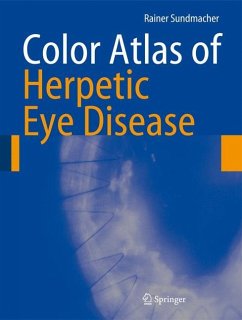
Varicella-Zoster Virus Epithelial Keratitis in Herpes Zoster Ophthalmicus
In Vivo Morphology in the Human Cornea

PAYBACK Punkte
34 °P sammeln!
Herpes zoster ophthalmicus (HZO) is a common disease in the elderly and the immunosuppressed, with potentially devastating sequelae. Diagnosis of HZO is clinical but almost all its manifestations are non-specific. The exception is varicella-zoster virus epithelial keratitis, which is frequently the only indicator of the true nature of the disease. This book is unique in presenting high-magnification images, obtained by non-contact in vivo photomicrography, that capture the distinctive features of varicella-zoster virus epithelial keratitis in HZO. Both the morphology and the dynamics of the co...
Herpes zoster ophthalmicus (HZO) is a common disease in the elderly and the immunosuppressed, with potentially devastating sequelae. Diagnosis of HZO is clinical but almost all its manifestations are non-specific. The exception is varicella-zoster virus epithelial keratitis, which is frequently the only indicator of the true nature of the disease. This book is unique in presenting high-magnification images, obtained by non-contact in vivo photomicrography, that capture the distinctive features of varicella-zoster virus epithelial keratitis in HZO. Both the morphology and the dynamics of the corneal epithelial lesions are splendidly documented, including in patients with HZO sine herpete and recurrent disease. Three rare cases of ocular surface involvement in acute HZO are included, and the final chapter carefully compares varicella-zoster virus epithelial keratitis in HZO and the lesions of herpes simplex virus.












